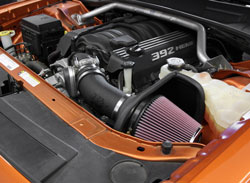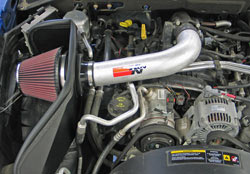
Cold Air Intake Systems 101
|
Cold Air Intake System 101
If you have even a casual interest in cars, then you've probably heard that installing a cold air intake system will give your car more power. And that's largely true, but the performance gains ultimately depend on the vehicle, and the type of performance intake system that's being used. A traditional type of performance intake uses a heat shield to prevent the air filter from ingesting warm engine bay air. This type of system can increase performance, by simply changing the quality of air going into the engine. But there's nothing 'simple' about engineering one of these cold air intake systems.
Why cold air is so important?
Fire can't exist in a vacuum, because it needs oxygen to fuel itself. So before the spark plugs can ignite the gasoline, the valves have to allow air into each cylinder. This oxygen is fed to the throttle body through an air intake system, which pulls air from a high-pressure zone, typically located at the front of the hot engine bay. Although this air is usually fairly cool, it can heat up as it travels through the intake tube. This reduces its potency, and causes power to be lost during each combustion cycle.
If you think back to 7th grade science class, you may remember that cold air has a higher density than warm air, because it contains more oxygen molecules. And since horsepower comes from the intensity of each fuel detonation, increasing the volume of oxygen in the fuel/air mixture will cause the fuel to burn more intensely. In laymen's terms, adding more cold air/oxygen will make the gas burn hotter, which will create more power. Following that simple horsepower formula has allowed K&N cold air intake systems to become one of the most popular performance upgrades on the market today.
Factory air intake systems
When car company engineers develop an air intake system, they have to factor in things like noise suppression, emission regulations, and the amount of room they have to work with (often referred to as 'packaging'). To meet the performance objectives for a particular model, they'll study the air temperature and air pressure zones under the hood. The air box is then placed in a low temperature zone, and the air box inlet is positioned in a high-pressure area, so it can collect cool outside air as flows through the bodywork. And finally, a sealed lid is used to keep the air filter from ingesting hot air coming off the engine. Factory air intakes might limit engine performance, but a lot of science goes into choosing that air box location.

K&N Cold air intake system installed
|
Classic cold air intake systems
Since the OEM air box is usually located in a low-temperature, high-pressure zone. Cold air intake systems can increase horsepower by replacing the restrictive stock intake, with components that are designed to handle a much larger volume of air. To ensure all that extra oxygen is cold, a low-restriction K&N performance air filter is positioned where the stock air box used to be. A rugged heat shield is then placed around the oversized air filter, to prevent hot engine air from getting into the system. The shape of the heat shield is specifically engineered to funnel cold air from that high pressure zone, directly into the air filter. While the outer edges of the K&N heat shield are often fitted with a special gasket, thus sealing against the underside of the hood to control the temperature and pressure of the air entering the system. This allows a K&N cold air intake system to boost performance, by simply improving on the factory design.
Choosing the right cold air intake system
Besides the performance benefits, legality is something that you need to consider. The California Air Resources Board (CARB) has very strict rules about performance intake systems. Many high performance cold air intake systems are not street legal in California, or any other state that has adopted California Emissions Standards. The K&N 57-Series FIPK performance intake systems on the other hand, is completely street legal in all 50 states, and it even comes with a CARB EO (executive order) number to comply with smog inspection.
K&N cold air intake systems mount the air cleaner high above the road surface. So engine performance won't be effected by the weather, or environmental conditions. But if you are concerned about those type of issues, K&N offers a water repellant DryCharger filter wrap. To find out which K&N cold air intake systems will fit your ride, use the search by vehicle tool, or use the dealer search tool to find a K&N dealer near you.
|












